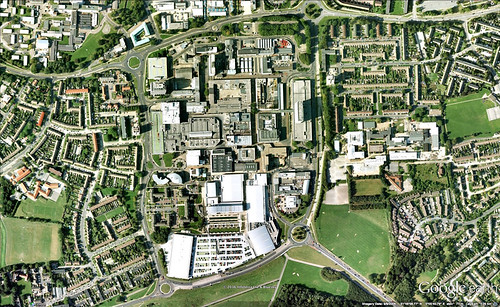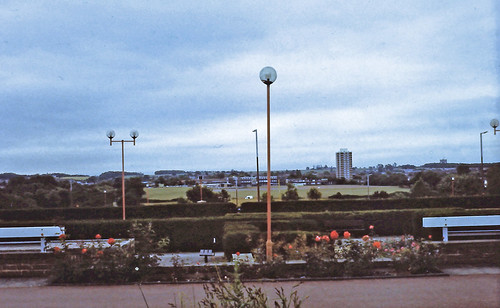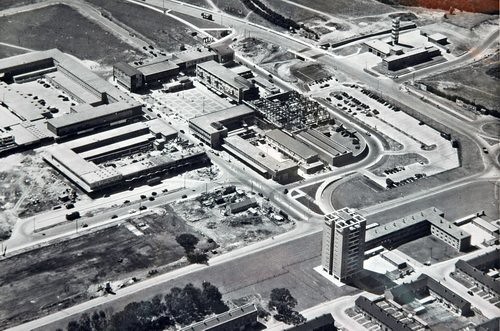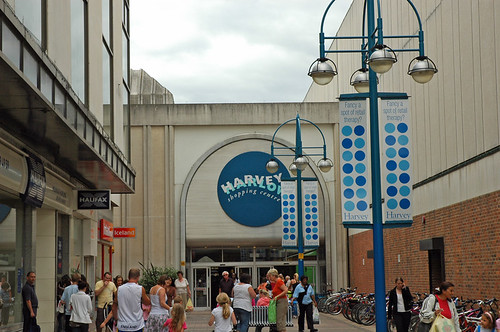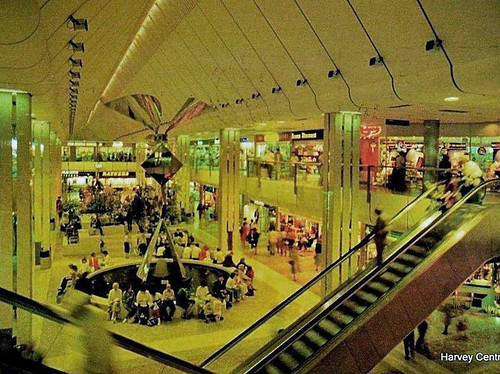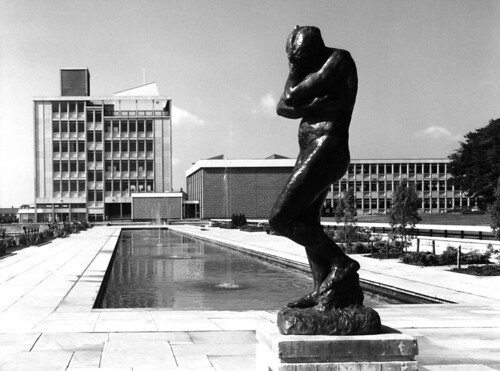The High
Gibberd's plan for the principal shopping complex incorporated not only a variety of sizes and types of retail outlets, but also office accommodation, the bus terminal, a large office block (Terminus House) with integral parking garage, the police station and magistrate’s court, library, a church and the Playhouse Theatre. He located The High on top of Dad’s Wood hill between two river valleys: the Stort to the north and Todd Brook to the south, and at the intersection of Second and Third Avenues and the green wedges through which they ran.
Car parking was provided by lots on the north, east and west of the central core. Against Gibberd’s advice, a parking lot was built south of the Water Gardens in 1966. Increasing population and affluence have led to much higher levels of car ownership than were anticipated in the 1950s. The English landscape has been seriously degraded by the need to accommodate more cars and the ubiquitous ‘wheelie bin’ and the despoliation of the original view from the Water Gardens southwards toward Rye Hill and Epping is one example.The High was centred on the first pedestrianized shopping precinct in the UK. It is difficult today to realize just how radical a concept this was in 1952. The original concept was that two parallel malls would join the market square on the north with the Town Hall and Civic Centre on the south. The composition was closed by the Water Gardens that looked out over the green wedge containing Second and Third Avenues so they would link the dense, highly ‘urban’ town centre with the surrounding landscape.
Major stores were located in Broadwalk, the major north-south corridor, and smaller shops in Little Walk. Little Walk was originally an open-air shopping arcade, but was later roofed over. After renovations in 2017, it was an interesting reflection of the changing ethnic composition of Harlow. Unfortunately it was closed in 2015, probably in anticipation of the redevelopment plans which were finally approved in 2017.
Gibberd intended the Market Place to be the principal space at the north end of the Town Centre because of his love for what he called ‘the oldest form of English shopping’. The first market was held in Stone Cross on 19th May 1956. Originally planned as a Tuesday and Saturday market it quickly became so popular that a Friday market was added in 1964 and a Thursday market in 1976. Temporary stall holders and truck-based butchers and other retailers continued to operate in the square for many years. However, the installation of permanent stalls in 2007 made it impossible for the market, as originally conceived, to operate. Those stalls have now been demolished, and the whole area awaits redevelopment.
The Harvey Centre, begun in 1979, represented another significant innovation. Enclosed, air-conditioned shopping malls were common in North America by this time, but were still a rarity in England. It took Gibberd some time to convince the local authorities that this would be a successful addition to The High. But, hating the flat ceilings that were typical of enclosed malls, he gave the central court of the Harvey Centre a high, tent-like ceiling modelled on the design of his own living room. The Centre is named after Ben Hyde Harvey who was General Manager of the Harlow Development Corporation and Chairman of the Memorial University Harlow Campus Trust from 1977 to 1999.
The focal point of the Harvey Centre was 'Solo Flight', a sculpture created in 1982 by the Lithuanian artist Antanes Bradys. It was dedicated to Sonia Anderson, member of Harlow Council from 1952 to 1997 and a trustee of the Harlow Art Trust. In the late 1990s the Centre was renovated and a glass-sided lift installed. The reconfiguration of the central area displaced the sculpture, and after its wings were reinforced, it was moved to its current site on First Avenue, opposite the church of St. Mary Latton.
The Town Hall overlooking the Water Gardens was supposed to be 14 storeys high but when built in 1958 it only had nine, making it a less impressive focal point than Gibberd had intended. In any case it was demolished in 2006 and the site incorporated into a whole new shopping area that incorporates some large chain stores, including ASDA (part of the Walmart empire), T.k. Maxx and Matalan.
The upper layer of the Water Gardens has 7 small fountains in a 250 yard long canal. The water flows out seven stylized lion’s heads into a second, lower canal and then flows into three lily ponds on the lowest level where Gibberd also placed small parterre gardens enclosed by yew hedges. The complex is considered a masterpiece of 20th century garden design and is listed Grade II on the English Heritage Statutory List and Grade II* on the Register of Parks and Gardens. This is a fitting tribute to Gibberd who was a life-long proponent of the value of gardens and sculpture in public spaces. Fortunately, plans to demolish the Water Gardens were thwarted, but they are now surrounded by commercial development that was never envisaged in Gibberd’s original plan. Two features of Harlow, the Water Gardens, and the Gibberd Garden on the site of his former home in Marsh Lane, are local examples of his dedication to the art of landscape gardening.
The High has struggled to adapt to the competition from an explosion of Big Box stores along Edinburgh Way and in other towns. The original anchor tenants in The High were Woolworth’s, Boots, Sainsbury, W.H. Smith and the London Cooperative Store. The LCS first traded in Broadwalk, and then built a Superstore in the Harvey Centre. After that closed, the site was subsequently occupied by British Home Stores. That store was one of the 164 BHS stores that closed in June 2016 when the chain went into receivership, and the space is vacant again at the time of writing (May 2019), having been temporarily occupied by Our House Home Furnishings. The former LCS site is now occupied by Fish Brothers Jewellery. Founded in 1930, this family-owned business is now in the hands of the seventh generation. They operate 14 shops in London and Essex, selling new and 'pre-owned' jewellery that hasn't been reclaimed by the 15 to 20 percent of owners that took advantage of the pawnbroking services offered by the company, and didn't return to claim their jewellery.
Marks and Spencer opened a store in Broadwalk in 1966 but it was a casualty of the M and S chain’s falling profits and closed in 2015. The company applied for permission to convert the store to a Simply Food operation, but Harlow Council rejected the application. The site has been renovated to accommodate smaller shops. Sainsbury, the grocery chain, originally traded in Broadwalk, then moved into a much larger space in the Harvey Centre before abandoning The High in the mid-1990s when it moved to a new superstore built on the former Gilbey’s site. Wilkinson’s now trades out of the former Sainsbury space.
Plans for a massive reconstruction of The High were approved in December 2017. A three-year planning permission was granted to a developer who intends to demolish the West Gate and replace it with four new buildings in Broadwalk, Market Square and West Gate. They will range in height from three to sixteen storeys, and will contain retail and office space as well as 447 new homes. The introduction of housing into the previously commercial-only area is a significant innovation that is intended to help revive the flagging fortunes of Gibberd's proud creation.
